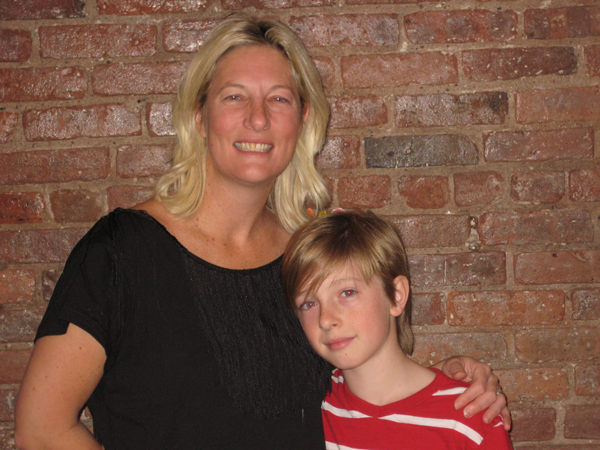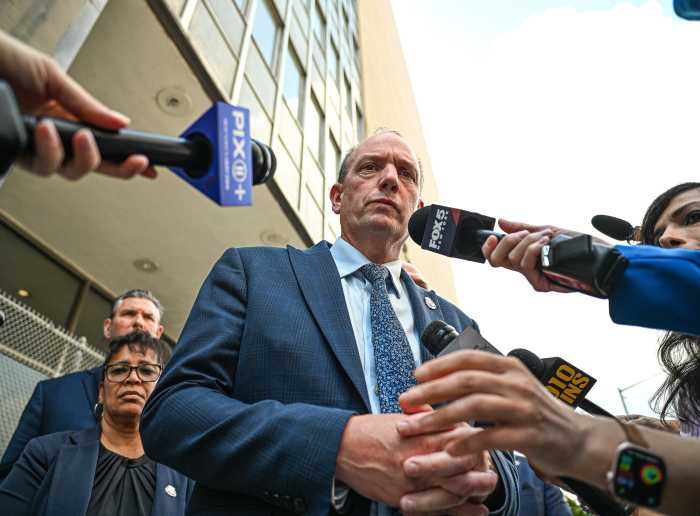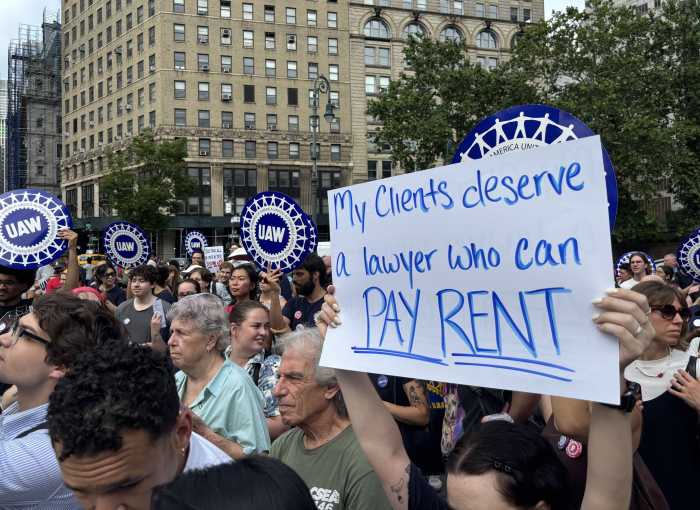BY DUSICA SUE MALESEVIC | For Tribeca resident Jessica Contrastano and her son Leo, a fifth grader at P.S. 41, the middle school application process began this summer.
Together, they went online to Inside Schools, a website affiliated with the New School, to look at videos of schools and check out the test scores of incoming students.
Contrastano was impressed by the amount of schools to choose from in District 2, an irregular-shaped area that covers almost all of Downtown and parts of the West Side and the Upper East Side.
She said it seemed like an “embarrassment of riches” because there are so many good choices.
By the fall, they had narrowed down the schools they wanted to check out and went on 12 tours, with Contrastano taking notes at each one. They also attended a middle school night at Stuyvesant High School where all the schools had tables and parents could chat with principals and current students.
|
Number Of Students Accepted At Downtown Middle Schools, 2014-15 |
|||||||||
|
SCHOOL |
NEIGHBORHOOD |
CHOICE 1 |
OFFERED SEATS |
CHOICE 2 |
OFFERED SEATS |
CHOICE 3 |
OFFERED SEATS |
TOTAL APPLICANTS |
TOTAL ACCEPTED |
|
Simon Baruch Academic (Zoned Program) |
Gramercy Park |
_ |
44 |
_ |
37 |
_ |
147 |
_ |
329 |
|
Simon Baruch (Special Progress) |
Gramercy Park |
100 |
149 |
346 |
_ |
194 |
_ |
960 |
149 |
|
Manhattan Academy of Technology (P.S./I.S. 126) |
Lower East Side/Chinatown |
221 |
65 |
195 |
_ |
138 |
_ |
806 |
121 |
|
Battery Park City School (P.S./I.S. 276) |
Battery Park City |
66 |
56 |
66 |
_ |
97 |
24 |
491 |
96 |
|
Sun Yat Sen Middle School (M.S. 131) Academic (Zoned Program) |
Lower East Side/Chinatown |
32 |
37 |
53 |
16 |
52 |
27 |
344 |
132 |
|
Sun Yat Sen Middle School (M.S. 131) (Special Progress) |
Lower East Side/Chinatown |
21 |
25 |
21 |
_ |
33 |
_ |
292 |
31 |
|
Salk School of Science (M.S. 255) |
Gramercy Park |
361 |
139 |
95 |
_ |
117 |
_ |
782 |
141 |
|
NYC Lab Middle School for Collaborative Studies |
Chelsea/Greenwich Village |
527 |
215 |
91 |
_ |
96 |
_ |
955 |
218 |
|
Quest to Learn |
Chelsea/Greenwich Village |
140 |
92 |
99 |
_ |
86 |
_ |
606 |
96 |
|
Lower Manhattan Community Middle School |
Lower East Side/Chinatown |
75 |
127 |
146 |
10 |
125 |
_ |
619 |
140 |
|
The data is from the Department of Education’s Office of Student Enrollment, Sept. 30, 2014. Most schools do not have the space for all the students that rank them as their first choice. |
“It was a bit overcrowded but we got to all the tables we were interested,” she said in a phone interview.
After the tours, research, talking with principals and understanding each school’s format and metrics, Contrastano and Leo, 10, were ready to rank their school choices.
“A lot of the schools that we were looking at — Salk, Baruch, Lab, Quest — they want you to put them first,” she said. “That’s a bit daunting. But we’ll see what happens. We feel pretty comfortable.”
After the baby and building boom in Lower Manhattan over the past decade, the middle school ranking system has been transformed with some saying that there really is no choice at all in a process that has become highly competitive and boiled down to the luck of the draw.
“There are so many children not getting into their first choice and their second choice and third choice now because of how competitive it’s become for those seats at our District 2 schools that we could have a crisis in that they won’t have any seat at all,” said Tricia Joyce, chairperson of Community Board 1’s Youth and Education Committee.

Jessica Contrastano and her son Leo hope he will be accepted to Lab School, where last year, 59 percent of the applicants who listed it as a first choice were rejected.
“The standards of admission for these middle schools have gotten higher,” she added. “My concern is that it’s going leave a lot of children behind.”
Joyce said that the board’s zoned school Baruch is not only really far away on E. 21st St., but it “is also going to become overcrowded. They are going to have to turn kids away. They can only take so many students.”
Theseus Roche, director of after-school activities for Manhattan Youth, based Downtown, agreed in part.
“You had more choices a few years ago,” he said in a phone interview. “You could put a first, second and third choice a few years ago and you felt that you were going to get one of those.”
The population in Community Board 1 — Tribeca, Financial District, the Seaport and Battery Park City — has grown dramatically from 34,420 in 2000 to 60,978 in 2010, according to an October Community Board 1 population report.
The birth rate in Lower Manhattan has also grown rapidly since 2000, according to data from the New York City Dept. of Health. There were 413 births in in 2000, compared to 1,013 in 2012, the latest year figures are available.
“It became such an increasing competitive process — meaning more or less the same number of school seats and a lot more kids going for them,” Roche said.
Roche, who has worked for Manhattan Youth for 13 years and lives in the Financial District, said that every year parents talk to him about this stressful procedure.
“For the most part, the thing that is really sort of terrifying for a lot of parents is that you don’t get to be aware of what goes into the algorithm, what gets you the placement,” he said.
Roche, whose daughter applied last year, likened the process to medical school students competing for a residency or fellowship.
“The process is daunting for families because the way that it happens is — they describe it like being in medical school where you put your choices in order of priority and you only get one offer,” he said.
Roche, whose daughter got into her first choice, Salk School of Science, said that they were very lucky. The plethora of good schools, including the zoned school Baruch, in District 2, he said, is fortunate for residents but that some schools have become more coveted.
“The thing that is causing so much anxiety, if you overshoot your first choice, you really are going to get kicked down to the bottom of the list or be sent to your zoned school,” he said. “The good news is that the zone school for us is actually a good school.”
A parent must learn much to navigate the process: what are each school’s application requirements, if a school is zoned or not, whether the placements are part of a screened or unscreened selection process or if the school utilizes a lottery system. Some applications are very involved while others require less.
Applications and the rankings for this year were due Dec. 2 and Contrastano said that she and Leo hope to find out whether he got into his first choice, the NYC Lab Middle School for Collaborative Studies in Chelsea, sometime in May.
Contrastano said that Leo loves math and the academic rigor of Lab combined with its location made it top choice. Contrastano also has two younger children and until the school at 75 Morton St. opens, she said that there really isn’t a local middle school nearby.
Lab administers a three-part test that includes literacy, math and a collaborative group exercise over three weekends in January. The school considers attendance and lateness as well as teacher comments, according to its website.
“This past year, more schools were telling parents that they had to put them first choice than ever before. It didn’t used to be that the schools could get away with saying put us first choice or good luck,” said Roche. “They’re not saying it with their nose in the air, they’re saying just because of the reality of what’s happening now, where historically, it seemed to be looser.”
This is a much different than when Contrastano was growing up in the Village and Soho and she and her sisters were zoned for the old I.S. 70, now home to Lab. Her parents decided instead to send them to Our Ladies of Pompeii School in the Village.
For Holly Noto, co-leader of 75 Morton Community Alliance, the application process is a world away from when she was growing up in a town of 1,800 people where one school building housed every grade.
Part of why Noto joined the alliance, a group of parents and community members who pushed for a middle school at 75 Morton St., which is slated to open in 2017, is talking to other parents about the application process.
“The reason why I was most interested is when I started to speak to parents who were going through the middle school admission process, it seemed to me that it was outlandish,” Noto said in a phone interview. “I can’t think of a better word for it. It felt like going through a college admission process.”
Noto, who has a third and fourth grader, has not yet been through the process, but it seemed to her that “an outrageous amount of time and an onerous effort on the part of parents and the students” and she wondered at the wisdom of putting that much stress on nine and ten-year-olds.
But through her work for the middle school, which she has been a part of for a little over a year, Noto has come to see that it is not that simple.
“I wish that my involvement had sort of led me to some great epiphany where my child would not have to go through the stress of taking tests and going through admission interviews and application process,” she said, “but I can see that if 75 Morton were to try to break from that, it would be unhealthy for the school and also unhealthy for the district.”
Noto, who lives in the Village, said that District 2’s Community Education Council is currently looking at guidelines for admission that might result in a less onerous and demanding process.
Nonetheless, Noto sees that “the admission process can be an asset in terms of helping to calibrate the numbers and calibrate the classroom sizes.”
Shino Tanikawa, president of the district’s C.E.C., said although two new middle schools just opened, it doesn’t look like there will be enough seats in the district.
“I base this partly on the fact that I don’t know of any middle schools in District 2 that have class sizes that are small enough,” she said in a phone interview. “I think most of the middle schools in District 2 have class sizes of 30, 33.”
In Lower Manhattan, the overcrowding of elementary schools that happened in 2008 affects middle schools now, said C.B. 1’s Joyce in a phone interview.
The bubble kindergarten class of 2008 — the year that Tribeca’s P.S. 234 had eight classes of kindergartens — went to middle school this September, explained Joyce. Her twin 10-year-old daughters went through the process this fall.
Demand for the middle school seats has gone up because of the amount of people, she said, and a look at Dept. of Education numbers show that a dramatically lower number of children were getting any of their choices.
Last year, Salk School of Science on E. 22nd St. and Lab on W. 17th St. offered seats to less than half of those students who put their school first while at Quest to Learn on W. 18th St., 65 percent of those who made them their top choice got an offer, according to D.O.E. data.
At Salk, 361 students made it their first choice out of 782 total applicants and 139 got an offer; at Lab, it was 215 who got an offer out of 527 first choices and 955 total who applied; and at Quest to Learn, 92 out of 140 first choice applicants got a spot out of 606 total, according to the D.O.E. data.
At Baruch, 149 students got an offer out of 960 applicants for “special progress,” a program for honor students, and 329 students got a spot in the zoned academic program, according to the D.O.E. data.
Joyce said that the hard work of C.B. 1 and elected officials got Spruce Street School and P.S. 276 built — despite the fact that the D.O.E. initially did not think the two K-8’s were needed.
She wants to see infrastructure, such as schools, tied to building “in a meaningful way.”
“You can’t have a population that doubles without having more school seats around. We have been saying it since 2003,” she said. “I don’t understand why I’m still trying to find out why New York City doesn’t plan infrastructure like other places, other cities. If you go to build 30,000 homes, schools are part of that plan generally.”
The problem is not the quality of District 2 schools, which are very good, said Joyce, but “there’s not enough of them for the amount of kids we now have.”
It is a difficult situation for the schools as well, as they can only interview so many children, she said.
Eric Greenleaf, a former P.S. 234 parent who has been doing detailed analyses of Lower Manhattan schools’ populations for many years, said, “most schools have put these limitations” on the ranking. “I think they are doing it because they don’t just have the resources to interview or test that many children.”
Not only has the middle school process become more competitive, he said, “It’s frankly becoming more of a roll of the dice and that’s what’s really unfair. It’s a very bad system and it needs to be changed.”
“What we have is, we no longer have choice at all,” said Joyce. “It’s very stressful, obviously, because of how this process has changed.”




































